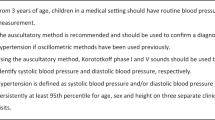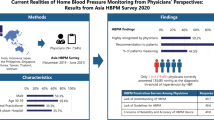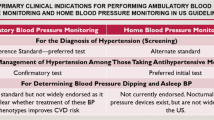Abstract
Twenty-four-hour ambulatory blood pressure monitoring (ABPM) is widely accepted as a more accurate method for measurement of blood pressure (BP) compared to a single office-based measurement of BP. However, it is unclear how physicians interpret ABPM and make management decisions. This study’s goal is to investigate variation in ABPM interpretation among paediatric nephrologists (Canada and UK) and paediatric cardiologists (Canada only) via an online survey. The survey content included baseline demographics, questions on the use and indications for ABPM, interpretation of results, and subsequent management decisions in various clinical scenarios. The survey was sent to 196 Canadian physicians, with 69 (35.2%) total responses. Thirty-five UK clinicians also completed the survey. Most respondents were >44 years old, were in practice for at least 11 years, and were university-based. There were substantial differences among clinicians in ABPM interpretation for isolated systolic, diastolic, and night-time hypertension. For example, only 53.1% of physicians would initiate or modify treatment in those with diastolic HTN in CKD. Further, even for the same abnormal ABPM parameter, the decision to start or alter treatment was influenced by the underlying medical condition. There is significant variation in clinical practice among physicians for interpretation and management of hypertension when using ABPM. Differences in guidelines among various jurisdictions, as well as knowledge gaps in the research on which guidelines are based, create ambiguity regarding ABPM interpretation and management decisions. A more protocolized approach and further insight into the reasoning behind the variation in physicians’ interpretation may help to standardise practice.
This is a preview of subscription content, access via your institution
Access options
Subscribe to this journal
Receive 12 digital issues and online access to articles
$119.00 per year
only $9.92 per issue
Buy this article
- Purchase on Springer Link
- Instant access to full article PDF
Prices may be subject to local taxes which are calculated during checkout



Similar content being viewed by others
Data availability
All data generated and analysed during this study are included in this published article and its corresponding supplementary information files.
Change history
11 July 2022
A Correction to this paper has been published: https://doi.org/10.1038/s41371-022-00711-y
References
Urbina E, Alpert B, Flynn J, Hayman L, Harshfield GA, Jacobson M, et al. Ambulatory blood pressure monitoring in children and adolescents: recommendations for standard assessment: a scientific statement from the American Heart Association Atherosclerosis, Hypertension, and Obesity in Youth Committee of the Council on Cardiovascular Disease in the Young and the Council for High Blood Pressure Research. Hypertension. 2008;52:433–51.
Din-Dzietham R, Liu Y, Bielo MV, Shamsa F. High blood pressure trends in children and adolescents in national surveys, 1963 to 2002. Circulation. 2007;116:1488–96.
Song P, Zhang Y, Yu J, Zha M, Zhu Y, Rahimi K, et al. Global prevalence of hypertension in children: a systematic review and meta-analysis. JAMA Pediatr. 2019;173:1154–63.
Go AS, Mozaffarian D, Roger VL, Benjamin EJ, Berry JD, Blaha MJ, et al. Heart disease and stroke statistics—2014 update: a report from the American Heart Association. Circulation. 2014;129:e28–e292.
Kannel WB. Hypertensive risk assessment: cardiovascular risk factors and hypertension. J Clin Hypertens. 2004;6:393–9.
Falkner B, Gidding SS, Portman R, Rosner B. Blood pressure variability and classification of prehypertension and hypertension in adolescence. Paediatrics. 2008;122:238–42.
Freedman DS, Goodman A, Contreras OA, DasMahapatra P, Srinivasan SR, Berenson GS. Secular trends in BMI and blood pressure among children and adolescents: the Bogalusa Heart Study. Paediatrics. 2012;130:e159–e166.
Chiolero A, Bovet P, Paradis G, Paccaud F. Has blood pressure increased in children in response to the obesity epidemic? Paediatrics. 2007;119:544–53.
Lande MB, Kaczorowski JM, Auinger P, Schwartz GJ, Weitzman M. Elevated blood pressure and decreased cognitive function among school-age children and adolescents in the United States. J Pediatr. 2003;143:720–4.
Bliziotis IA, Destounis A, Stergiou GS. Home versus ambulatory and office blood pressure in predicting target organ damage in hypertension: a systematic review and meta-analysis. J Hypertens. 2012;30:1289–99.
Sorof JM, Cardwell G, Franco K, Portman RJ. Ambulatory blood pressure and left ventricular mass index in hypertensive children. Hypertension. 2002;39:903–8.
McNiece KL, Gupta-Malhotra M, Samuels J, Bell C, Garcia K, Poffenbarger T, et al. Left ventricular hypertrophy in hypertensive adolescents: analysis of risk by 2004 National High Blood Pressure Education Program Working Group staging criteria. Hypertension. 2007;50:392–295.
Stergiou GS, Giovas PP, Kollias A, Rarra VC, Papagiannis J, Gergakopoulos D, et al. Relationship of home blood pressure with target-organ damage in children and adolescents. Hypertens Res. 2011;34:640–4.
Flynn JT, Daniels SR, Hayman LL, Maahs DM, McCrindle BW, Mitsnefes M, et al. Update: ambulatory blood pressure monitoring in children and adolescents: a scientific statement from the American Heart Association. Hypertension. 2014;63:1116–35.
Dionne JM, Harris KC, Benoit G, Feber J, Poirier L, Cloutier L, et al. Hypertension Canada’s 2017 guidelines for the diagnosis, assessment, assessment, prevention, and treatment of pediatric hypertension. Can J Cardiol. 2017;33:577–85.
Lurbe E, Agabiti-Rosei E, Cruickshank JK, Dominiczak A, Erdine S, Hirth A, et al. European Society of Hypertension guidelines for the management of high blood pressure in children and adolescents. J Hypertens. 2016;34:1–34. 2016
Sharma AP, Altamirano-Diaz L, Mohamed Ali M, Stronks K, Kirpalani A, Filler G, et al. Diagnosis of hypertension: ambulatory paediatric American Heart Association/European Society of Hypertension versus blood pressure load thresholds. J Clin Hypertens. 2021;23:1947–56.
Sharma AP, Norozi K, Grattan M, Filler G, Altamirano-Diaz L. Diagnosis of paediatric hypertension: European Society of Hypertension-recommended 24-hour vs. 24-hour-day-night ambulatory blood pressure thresholds. Am J Hypertens. 2021;34:198–206.
Sharma A, Altamirano-Diaz L, Grattan M, Filler G, Sharma AP. Comparative analysis of American Heart Association and European Society of Hypertension ambulatory blood pressure thresholds for diagnosing hypertension in children. Kidney Int Rep. 2020;5:611–7.
Sharma AP, Mohammed J, Thomas B, Lansdell N, Norozi K, Filler G. Nighttime blood pressure, systolic blood pressure variability, and left ventricular mass index in children with hypertension. Pediatr Nephrol. 2013;28:1275–82.
Bostanci BK, Civilibal M, Elevli M, Duru NS. Ambulatory blood pressure monitoring and cardiac hypertrophy in children with metabolic syndrome. Pediatr Nephrol. 2012;27:1929–35.
Wang C, Zhang J, Deng W, Gong W, Liu X, Zengchun Y, et al. Nighttime systolic blood-pressure load is correlated with target-organ damage independent of ambulatory blood-pressure level in patients with non-diabetic chronic kidney disease. PLoS One. 2015;10:1–13.
Li Y, Thijs L, Boggia J, Asayama K, Hansen TW, Kikuya M, et al. Blood pressure load does not add to ambulatory blood pressure level for cardiovascular risk stratification. Hypertension. 2014;63:925–33. (2014)
Liu M, Li Y, Wei F-F, Zhang L, Han J-L, Wang J-G. Is blood pressure load associated, independently of blood pressure level, with target organ damage? J Hypertens. 2013;31:1812–8.
Whelton PK, Carey RM, Aronow WS, Casey DE, Collins KJ, Himmelfarb CD, et al. 2017 ACC/AHA/AAPA/ABC/ACPM/AGS/APhA/ASH/ASPC/NMA/PCNA guideline for the prevention, detection, evaluation, and management of high blood pressure in adults: a report of the American College of Cardiology/American Heart Association task force on clinical practice guidelines. J Am Coll Cardiol. 2018;71:e127–e248.
Lee J, McCulloch CE, Flynn JT, Samuels J, Warady BA, Furth SL, et al. Prognostic value of ambulatory blood pressure load in paediatric CKD. Clin J Am Soc Nephrol. 2020;15:493–500.
Mitsnefes M, Flynn JT, Brady T, Baker-Smith C, Daniels SR, Hayman LL, et al. Paediatric ambulatory blood pressure classification: the case for change. Hypertension. 2021;78:1206–10.
Lee H, Yano Y, Cho SMJ, Park JH, Park S, Lloyd-Jones DM, et al. Cardiovascular risk of isolated systolic or diastolic hypertension in young adults. Circulation. 2020;141:1778–86.
Sundstrom J, Neovius M, Tynelius P, Rasmussen F. Association of blood pressure in late adolescence with subsequent mortality: cohort study of Swedish male conscripts. BMJ. 2011;342:1–11.
Alsaeed H, Metzger DL, Blydt-hansen TD, Rodd C, Sharma A. Isolated diastolic high blood pressure: a distinct clinical phenotype in US children. Pediatr Res. 2021;90:903–9.
Wang C, Ye Z, Li Y, Zhang J, Zhang Q, Ma X, et al. Prognostic value of reverse dipper blood pressure pattern in chronic kidney disease patients not undergoing dialysis: prospective cohort study. Sci Rep. 2016;6:1–8.
Fan H, Li Y, Thijs L, Hansen TW, Richart T, Kikuya M, et al. Prognostic value of isolated nocturnal hypertension on ambulatory measurement in 8711 individuals from 10 populations. J Hypertens. 2010;28:2036–45.
Hamdani G, Nehus EJ, Hanevold CD, Van Sickle JS, Woroniecki R, Wenderfer SE, et al. Ambulatory blood pressure, left ventricular hypertrophy and allograft function in children and young adults after kidney transplantation. Transplantation. 2017;101:150–6.
Thijs L, Hansen TW, Kikuya M, Li Y, Richart T, Ohkubo T, et al. Is blood pressure during the night more predictive of cardiovascular outcome than during the day? Blood Press Monit. 2008;13:145–7.
Gavriilaki M, Nikolaidou B, Gavriilaki E, Anyfanti P, Lazaridis A, Gavriilaki E, et al. Nighttime dipping status and risk of cardiovascular events in patients with untreated hypertension: a systematic review and meta-analysis. J Clin Hypertens. 2020;22:1951–9.
Acknowledgements
We would like to acknowledge all physicians who responded to our survey from UK and Canada.
Author information
Authors and Affiliations
Contributions
All authors provided substantial contributions to conception and design, acquisition of data, or analysis and interpretation of data; drafted the article or revised it critically for important intellectual content; and provided final approval of the version to be published.
Corresponding author
Ethics declarations
Competing interests
The authors declare no competing interests.
Ethics approval
Ethics approval was acquired from the Hamilton Integrated Research Ethics Board (HiREB; project number 11383). The requirement for survey respondent consent was waived, as completion of the survey would confirm the respondents’ consent.
Additional information
Publisher’s note Springer Nature remains neutral with regard to jurisdictional claims in published maps and institutional affiliations.
The original online version of this article was revised: Due to an error in the corresponding authorship.
Rights and permissions
About this article
Cite this article
Stefanova, I.Z., Sinha, M.D., Stewart, D.J. et al. Variation in paediatric 24-h ambulatory blood pressure monitoring interpretation by Canadian and UK physicians. J Hum Hypertens 37, 363–369 (2023). https://doi.org/10.1038/s41371-022-00702-z
Received:
Revised:
Accepted:
Published:
Issue Date:
DOI: https://doi.org/10.1038/s41371-022-00702-z
This article is cited by
-
Updates to Pediatric Ambulatory Blood Pressure Monitoring in Clinical Practice: a Review and Strategies for Expanding Access
Current Pediatrics Reports (2022)



